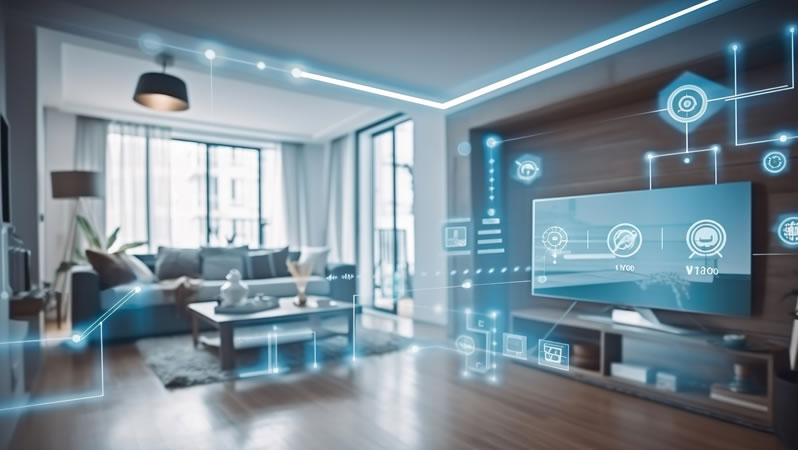In 2024, the landscape of smart homes is undergoing a significant transformation, driven by advancements in technology, increased adoption of artificial intelligence (AI), and a focus on enhancing efficiency. This year marks a pivotal moment as we witness a surge in the availability and compatibility of smart home devices, accompanied by a growing emphasis on universal standards, AI integration, and the introduction of innovative appliances. Let’s delve deeper into the key developments shaping the smart home ecosystem in 2024.

Rise of Universal Standards: The Matter Protocol
One of the notable shifts in the smart home arena is the gradual acceptance and implementation of universal standards, particularly the Matter protocol. Initially introduced in 2022, Matter aimed to streamline interoperability among various smart devices, promising seamless integration across different ecosystems. While its adoption may have been gradual, the release of version 1.2 in October 2023 marked a significant milestone, expanding compatibility to include a broader range of devices such as robot vacuums, air purifiers, and dishwashers.
Companies like SwitchBot and Panasonic have already embraced the Matter standard in their products, signaling a growing momentum towards universal compatibility. As more manufacturers incorporate Matter into their offerings, consumers can expect greater flexibility and ease of integration within their smart home ecosystems, fostering a more cohesive and interconnected environment.
Diversification of Smart Home Appliances
In 2024, the smart home landscape is witnessing a proliferation of intelligent appliances beyond the traditional categories of smart speakers and thermostats. Manufacturers are expanding their product portfolios to include a wide array of smart devices for various household applications, ranging from kitchen appliances to home security systems.
LG, for instance, has introduced a range of smart appliances equipped with ThinQ app support, enabling seamless integration with voice assistants like Alexa for convenient hands-free control. Furthermore, upcoming events like the Consumer Electronics Show (CES) are expected to unveil a plethora of innovative smart home appliances, such as pet doors and smart blinds, catering to diverse consumer needs and preferences.
Embracing Efficiency through IoT
Efficiency emerges as a central theme in the evolution of smart homes, with a growing emphasis on leveraging the Internet of Things (IoT) to optimize energy consumption and streamline daily routines. While basic automation features have been prevalent in smart devices, 2024 heralds a new era of holistic IoT solutions aimed at creating more intelligent and adaptive environments.
Manufacturers are integrating advanced scheduling and automation capabilities into their products, enabling users to orchestrate complex routines and optimize resource utilization. Whether it’s scheduling the operation of smart pet doors or adjusting smart blinds based on environmental conditions, the convergence of AI and IoT promises to revolutionize how we interact with our homes.
The Promise of AI-Powered Robotics
One of the most exciting developments in the realm of smart homes is the emergence of AI-powered robotics, heralding a new era of personalized and interactive home assistants. While early iterations of personal robots may have been rudimentary, advancements in AI technology are paving the way for more sophisticated and intuitive companions.
Companies like Enabot are already introducing personal robots capable of autonomous navigation and interaction, albeit with room for improvement in AI integration. As AI algorithms evolve and become more pervasive, we can anticipate a proliferation of intelligent robot companions offering a range of functionalities, from home security to household chores.
Affordability Driving Accessibility
As smart home technology matures, a notable trend in 2024 is the increasing affordability of connected devices, making them more accessible to a wider audience. While cutting-edge innovations like AI-powered robots may command premium prices, the overall cost of entry into the smart home ecosystem is decreasing.
Consumers can now enjoy the benefits of smart connectivity without breaking the bank, thanks to competitively priced devices such as smart speakers, lighting systems, and kitchen appliances. This democratization of smart home technology ensures that the benefits of automation and connectivity are within reach for households of varying budgets.
Conclusion: A Transformative Year for Smart Homes
In summary, 2024 represents a transformative year for smart homes, characterized by widespread adoption, technological innovation, and a focus on enhancing efficiency and accessibility. The proliferation of universal standards like Matter, coupled with the integration of AI and IoT, promises to usher in a new era of interconnected living spaces.
As the boundaries between science fiction and reality blur, AI-powered robots are poised to become indispensable companions, while affordability ensures that smart home technology is not just a luxury but a mainstream reality. With each passing year, the smart home ecosystem continues to evolve, offering endless possibilities for convenience, comfort, and sustainability in the modern household.




